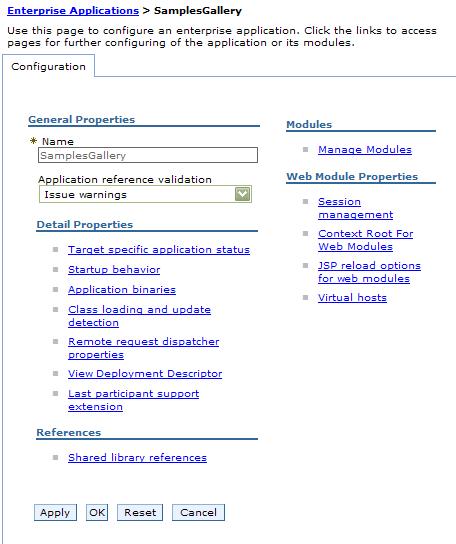Configure J2EE applications
Overview
You can change the configuration of an application or module deployed on a server.
You can change the contents of and deployment descriptors for an application or module before deployment, such as in an assembly tool. However, it is assumed that the module is already deployed on a server.
Change an application or module configuration consists of one or more of the following:
- Change the settings of the application or module.
- Removing a file from an application or module.
- Updating the application or its modules.
This topic describes how to change the settings of an application or module using the console.
Procedure
- View current settings of the application or module.
Click...
Applications | Enterprise Applications | application

...to access the settings page for the enterprise application.
Many application or module settings are available on other console pages that you can access by clicking links on the settings page for the enterprise application.
- Map each module of your application to a target server.
Specify the appservers, clusters of appservers, or Web servers onto which to install modules of your application.
- Change how quickly your application starts compared to other applications or to the server.
- Configure the use of binary files.
- Change how your application or Web modules use class loaders.
- Map a virtual host for each Web module of your application.
See also: Configure virtual hosts
- Change application bindings or other settings of the application or module.
- Click...
Applications | Enterprise Applications | application | property_or_item_name
...in the console navigation tree. From the application settings page, you can access console pages for further configuring of the application or module.
- Target specific application status
- Remote request dispatch properties
- Security role to user/group mapping
- View deployment descriptor
- Last participant support extension
- Application scope resources
- Resource references
- EJB references
- Shared library references
- Initial parameters for servlets
- Session management
- Context root for Web modules
- JSP reloading options for Web modules
- Environment entries for Web modules
- Virtual hosts
- Stateful session bean failover (applications)
- Stateful session bean failover (EJB modules)
- Application profiles
- 2.x CMP bean data sources
- 2.x entity bean data sources.
- EJB JNDI names
- Correct use of system identity
- Provide JMS and EJB endpoint URL information
- Publish WSDL files
- Provide HTTP endpoint URL information
- Web modules
- EJB modules
- Change the values for settings as needed, and click OK.
- Click...
- Optional: Configure the application so it does not start automatically when the server starts. By default, an installed application starts when the server on which the application resides starts. You can configure the target mapping for the application so the application does not start automatically when the server starts. To start the application, then start it manually.
- If the installed application or module uses a resource adapter archive (RAR file), ensure that the Classpath setting for the RAR file enables the RAR file to find the classes and resources that it needs. Examine the Classpath setting on the console Resource adapter settings page.
Results
The application or module configuration is changed. The application or standalone Web module is restarted so the changes take effect.
What to do next
If the application or module is deployed on a cluster and you have no more configuration changes to make, click Rollout Update on the Enterprise Applications page to propagate the changed configuration on all cluster members of the cluster on which the application or module is deployed. Rollout Update sequentially updates the configuration on the nodes that contain cluster members.
Save changes to your administrative configuration.
In the ND product, the application binaries are transferred to nodes when the configuration changes on the deployment manager synchronize with configurations for individual nodes on which the application will run.
Application bindings
Configure application startup
Configure binary location and use
Configure the use of class loaders by an application
Manage modules settings
Mapping modules to servers
Mapping virtual hosts for Web modules
Mapping properties for a custom login configuration
Related tasks
Deploying and administering J2EE applications